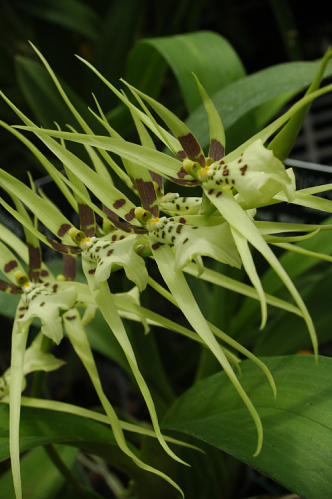On Display: Spectacular Spider Orchids
May 13, 2016 at 8:50 am smithsoniangardens Leave a comment
The Smithsonian Gardens Orchid Collection contains an amazing assortment of species and hybrids. I come to work each day with great anticipation of what new marvel has unfurled overnight. I am never disappointed. Our interiorscape staff selects the most stunning plants for our orchid display cases outside the Warner Bros. Theater on the first floor of the National Museum of American History (NMAH). This week’s display features a group of orchids from one of my favorite genera, the fascinating Brassia.

Brassia Rex ‘Sakata’ from the Smithsonian Gardens Orchid Collection on display at the National Museum of American History.
Better known as spider orchids, Brassias are beloved for their long, narrow, ribbony sepals and petals. One of the orchids currently on display is Brassia Rex, a hybrid of Brassia verrucosa X Brassia giroudiana, which is known to have greater vigor and larger flowers than either parent. Created in the 1960s by the venerable orchid breeder Goodale Moir, this exceptional hybrid is a wonderful addition to every collection that has space for it. Beware, however, as it can grow into a monstrously large plant.

Brassia Rex, 2009-1460A, Smithsonian Gardens Orchid Collection.
It has long been believed that Brassias evolved flowers which—through a strategy known as brood site deception—mimic the appearance of spiders in order to attract female parasitic wasps of the genera Pepsis and Campsomeris that target spiders as hosts on which to lay their eggs. This ‘imitation’ strategy is evident in many types of orchids that use flower smell, color, and texture to appear to be suitable places for pollinators to deposit their progeny. Ecologists in Central America, however, have recently noted that while parasitic wasps do indeed visit Brassias and pollinate them, they do not appear to lay eggs on these orchids. As a result, this finding disproves brood site deception as the reason for Brassias’ spider-like appearance. While the true reason for the spider orchid’s form remains unknown, discussion at a recent orchid conference brought up the possibility that these wasps simply like the look of these flowers.
This raises a fascinating question I’ve been mulling over recently: Is it possible that there is an aesthetic component to orchid evolution? Charles Darwin thought this to be the case and pointed to the sexual selection of mates in various animal species as evidence. Perhaps pollinators also select showy flowers such as Brassias for their ‘attractiveness.’ This question has yet to be answered and is just one of the many reasons I find the mysterious field of orchid ecology so fascinating.
-Tom Mirenda, Smithsonian Gardens Orchid Collection Specialist
Entry filed under: Collections, Orchids. Tags: flowers, living collections, National Museum of American History, orchids.

Trackback this post | Subscribe to the comments via RSS Feed